Sections
- Test Your Well Water Quality
- Winona County Rural Climate Dialogues
- Community Water Monitoring Project Launch
- Our Winona Woods Campaign Eradicating Oriental Bittersweet Infestation
Test Your Well Water Quality
In 2015 the Minnesota Department of Agriculture (MDA) conducted a major revision of the Nitrogen Fertilizer Management Plan and with that came the Township Testing Program to assess concentrations of nitrate-nitrogen in private wells at the township scale. The drinking water standard for nitrate is 10 parts per million and while nitrate-nitrogen can occur naturally in groundwater, it’s typically around levels of 0 to 3 ppm. Human activities like sewage disposal, livestock production, and crop fertilization can elevate levels which can have negative effects on human health. The MDA identified townships around the state that were vulnerable to groundwater contamination and had significant row crop production, prioritizing a list for scheduled testings.
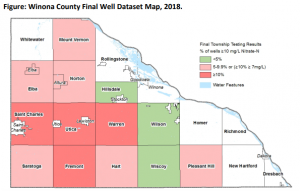 Identified as a priority area, over 900 wells in townships of Winona County were tested as part of the Township Testing Program. Four Winona County townships had more than 10% of their wells over the Health Standard of 10 ppm with some ranging upwards of 40%. The data collected from this program helps the MDA focus any future work within the County and the more wells that get tested, the better the information to determine next steps. It’s suggested that owners of private wells test yearly for both coliform bacteria and all anions (nitrate, nitrite, fluoride, chloride, and sulfate) to ensure sanitary drinking water.
Identified as a priority area, over 900 wells in townships of Winona County were tested as part of the Township Testing Program. Four Winona County townships had more than 10% of their wells over the Health Standard of 10 ppm with some ranging upwards of 40%. The data collected from this program helps the MDA focus any future work within the County and the more wells that get tested, the better the information to determine next steps. It’s suggested that owners of private wells test yearly for both coliform bacteria and all anions (nitrate, nitrite, fluoride, chloride, and sulfate) to ensure sanitary drinking water.
Winona County has test kits available for purchase at the Household Hazardous Waste Facility located at 225 West 2nd Street in Winona. Two test kits are available, one for coliform bacteria and the other for anions. Kits are $32 each or a combo kit is available for $54. The Household Hazardous Waste Facility is open Monday through Friday from 8am to 4:30pm. See their website for more on test kits.
Winona County Rural Climate Dialogues
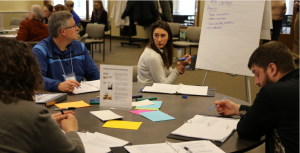
In March of 2016 eighteen Winona County residents, demographically reflective of Winona County, participated in the Winona County Climate Dialogue to decide how Winona County could best address extreme weather and a changing climate to remain a resilient community. The program, Rural Climate Dialogues, is run by the Institute for Agriculture and the Trade Policy and the Jefferson Center who seek to strengthen democracy by advancing informed, citizen-developed solutions to public issues. Over the course of three days participants prioritized challenges, opportunities for response, and both individual and community wide actions to address those challenges. Many of the recommendations related to water quality and energy issues with a pilot project continuing to implement many of the recommendations.
 This weekend, the Dialogues continue with the Winona County Energy Dialogue. In this chapter of the Rural Dialogues program, 21 community members will gather to discuss the energy system, and what the future of Winona County’s energy system could look like. The group will hear from experts speaking on the topic of Energy Sources, Utility Perspectives, and Consumers Perspectives, in addition to a crash-course in how the energy system works and what it looks like in Winona County. Following the presentations, the participants will deliberate in small groups to prioritize challenges and opportunities, and create action plans to strengthen the energy system. We look forward to hearing what this group’s ultimate recommendations are, and encourage you to stop by for part of the event, which will be held at the Winona County Historical Society. For more information or to take a look at the event agenda, email Camille, Program Coordinator for the Jefferson Center.
This weekend, the Dialogues continue with the Winona County Energy Dialogue. In this chapter of the Rural Dialogues program, 21 community members will gather to discuss the energy system, and what the future of Winona County’s energy system could look like. The group will hear from experts speaking on the topic of Energy Sources, Utility Perspectives, and Consumers Perspectives, in addition to a crash-course in how the energy system works and what it looks like in Winona County. Following the presentations, the participants will deliberate in small groups to prioritize challenges and opportunities, and create action plans to strengthen the energy system. We look forward to hearing what this group’s ultimate recommendations are, and encourage you to stop by for part of the event, which will be held at the Winona County Historical Society. For more information or to take a look at the event agenda, email Camille, Program Coordinator for the Jefferson Center.
Community Water Monitoring Project Launch
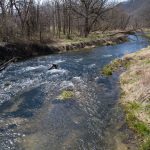
Winona County has several impaired rivers and streams, meaning the water quality of those waterbodies is not meeting the State’s standards. Agricultural practices to prevent erosion and sedimentation, monitoring by students at area colleges, and citizen engagement by community groups have certainly helped bring this important issue to light however. In an effort to build upon these initiatives Sustain Winona and partner Izaak Walton League of America offered “Save our Streams”, a workshop to train volunteers on water quality monitoring through the sampling of invertebrates. This conservation initiative already in place by the Izaak Walton League is helping obtain a clearer picture of water-quality across the country and now trained volunteers in Winona County can assist in data collection needed for restoration.
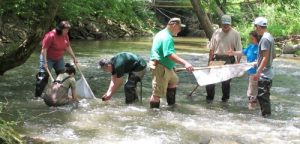 To continue to engage the community and new volunteer stream monitors after March’s workshop, Sustain Winona is hosting a water quality monitoring launch event. The event will take place in August at Farmer’s Park and will help build a group of people interested in learning more and becoming involved with water quality monitoring efforts while of course, having fun! The event will feature demonstrations on monitoring different data points such as physical, chemical, and invertebrates. It will also have food and some other surprises in store. Conservation as been a core part of the Izaak Walton League of America and together with Sustain Winona they hope to build a volunteer group for regular sampling of our local streams and continue raising awareness on what’s going on with our water, not just locally, but all over our region. Keep an eye out over the next month for more details on August’s Community Water Monitoring launch event and like Sustain Winona on Facebook to receive updates.
To continue to engage the community and new volunteer stream monitors after March’s workshop, Sustain Winona is hosting a water quality monitoring launch event. The event will take place in August at Farmer’s Park and will help build a group of people interested in learning more and becoming involved with water quality monitoring efforts while of course, having fun! The event will feature demonstrations on monitoring different data points such as physical, chemical, and invertebrates. It will also have food and some other surprises in store. Conservation as been a core part of the Izaak Walton League of America and together with Sustain Winona they hope to build a volunteer group for regular sampling of our local streams and continue raising awareness on what’s going on with our water, not just locally, but all over our region. Keep an eye out over the next month for more details on August’s Community Water Monitoring launch event and like Sustain Winona on Facebook to receive updates.
Our Winona Woods Campaign Eradicating Oriental Bittersweet Infestation
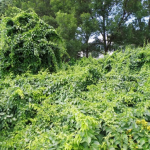 With the largest infestation of Oriental Bittersweet in the state of Minnesota, management efforts are greatly needed within Winona County as this invasive species continues to threaten our area woodlands. Funded by a grant from the Minnesota Department of Agriculture, the Our Winona Woods campaign will kick off this summer running through the end of October to help
With the largest infestation of Oriental Bittersweet in the state of Minnesota, management efforts are greatly needed within Winona County as this invasive species continues to threaten our area woodlands. Funded by a grant from the Minnesota Department of Agriculture, the Our Winona Woods campaign will kick off this summer running through the end of October to help 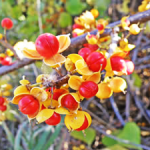 landowners eradicate Oriental Bittersweet on their property. A group of local, Winona are residents have already been hard at work removing the species from various locations around the County but will now have additional help from a seasonal intern thanks to this grant. In addition to participating as team member in the Our Winona Woods campaign to help educate all County residents on the removal of invasive species, the intern will also work one-on-one with landowners.
landowners eradicate Oriental Bittersweet on their property. A group of local, Winona are residents have already been hard at work removing the species from various locations around the County but will now have additional help from a seasonal intern thanks to this grant. In addition to participating as team member in the Our Winona Woods campaign to help educate all County residents on the removal of invasive species, the intern will also work one-on-one with landowners.
If you think you have Oriental Bittersweet or other invasive species (Poison Hemlock, Japanese Knotweed, etc) on your property, reach out to the campaign and someone will stop by to confirm the infestation. From there, Our Winona Woods will work with you to remove the infestation from your property. Email ourwinonawoods@gmail.com or call 507-457-6468 for more information or have a member of the campaign visit your property.
I am interested in helping remove oriental bittersweet in Winona County. I live in the Treetops neighborhood of Winona, and there is still a great deal of oriental bittersweet growing here, primarily on unsold lots and some of what I presume is City property. Crews have removed this bittersweet over the past couple years, but it is growing back quickly. There are some beautiful trees that might still be saved if this invader could be removed each year.
I have also noticed that there is still Oriental bittersweet growing along the trail around Lake Winona.
@Coleen – that’s great news! We’ll have someone from the County reach out to you directly. You’re right that it is a big problem. We feel fortunate that folks like you are willing to put in the time to eradicate it!